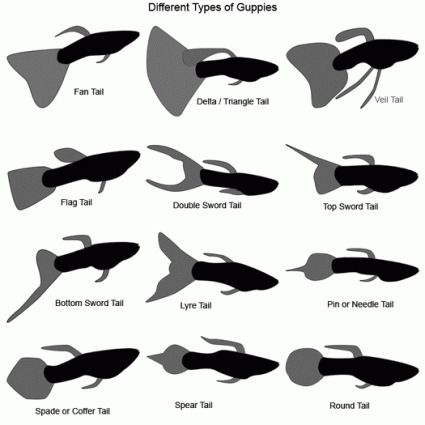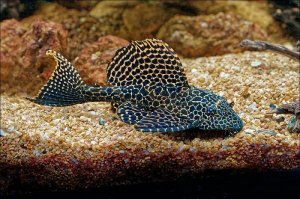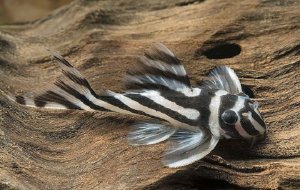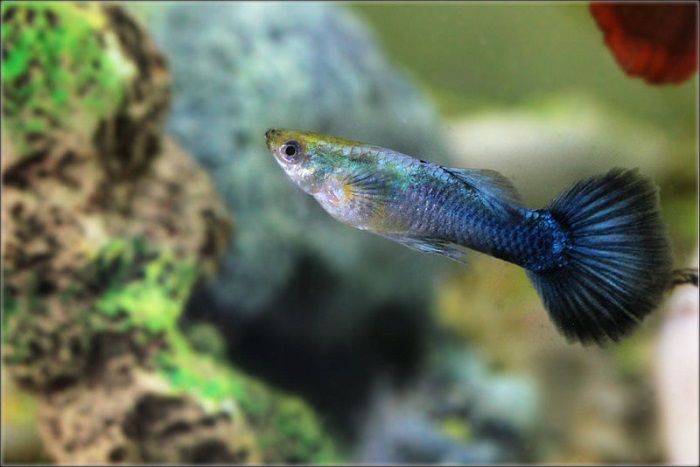
The Blue Guppy is an Extraordinary color variation of this peaceful and easy-going tropical fish species. There are different types of Blue Guppies from lighter shades to darker, and more metallic hues. Guppies are relatively easy to care for and ideal for beginners. So, let us look a bit further into the Blue Guppy color Variations, and how to care for this magnificent but small fish species.
Breed Overview
| Origin | Northeast South America. |
| Lifespan | 1-3 years, 5-year maximum. |
| Size | Males 1.5– 3.5cm (0.6 – 1.4 Inches), Females 3–6 cm (1.2–2.4 Inches). |
| Colors | Solid or Bi-Color Blue, Sky Blue, Neon Blue, Dark Blue. |
| Food | Omnivores. |
| Tank Size | 10 – 20 Gallons. |
| Temperament | Peaceful, Social, Shoaling. |
| Water Temperature | 78–82°F (25.5–27.8°C). |
| Water pH | 8.5 Brackish Water. |
| Difficulty Level | Beginner Easy. |
Guppy Species Summary
The Blue Guppy (Poecilia reticulata), many times also referred to as the Million fish or rainbowfish is one of the most striking color species of the guppy, the world’s most popular and widely distributed tropical fish. Guppies are mostly native to South America, though they are found all over the world today, in almost any pet store. They enjoy mostly freshwater bodies, though they can thrive and adapt to almost any water conditions, even brackish water.
Guppies are live-bearing and they are ardent breeders that will quickly fill up your aquarium if they do not manage to eat their young first. The Blue Guppy is a much rarer species with a few color varieties such as the neon Blue Guppy, the Light, and Dark Blue Guppy.
Blue Guppy Color Variations
In the Blue Guppy there are three different color variants;
1. The Blue Guppy
The Basic Blue Guppy will have a light or dark electric blue tail with a red body or a brown to the silver body in their Delta Tail variant.
2. The Neon Guppy
The Neon or Neon Blue Guppy has an extraordinarily bright neon blue tail that is slightly paler, almost turquoise in color, in comparison to the basic Blue Guppy.
3. The Japanese Blue Guppy
The Japanese Blue Guppy is an Exquisite Metallic blue that will range from very light to an almost deep midnight blue color. The Japanese Blue swordtail is the most popular among aquarists.
Tail Variations
Another extremely interesting disparity in guppies is their tail variations which include;
|
|
1. FanTail 2. Delta / Triangle Tail 3. Veil Tail 4. Flag Tail 5. Double SwordTail. 6. Top SwordTail. 7. Bottom Sword-Tail. 8. Lyre Tail. 9. Pin or Needle Tail 10. Spade or Coffer Tail. 11. Spear Tail. 12. Round Tail.
|
Sexual Dimorphism In Guppies
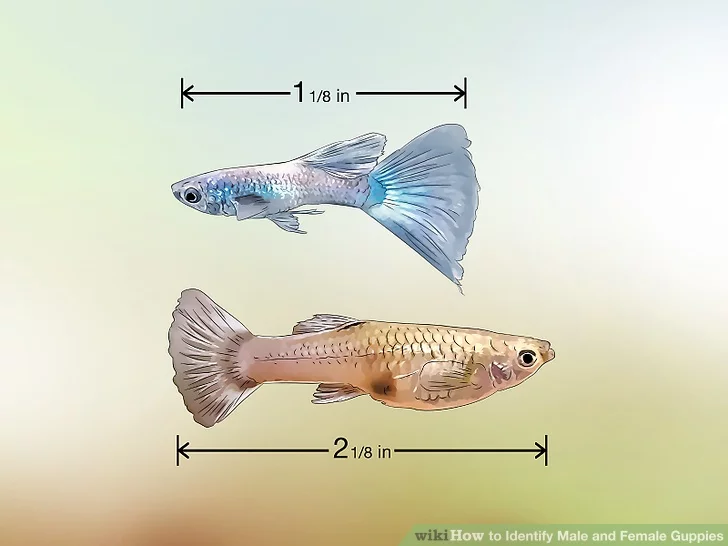
One critical factor about guppies is the vast difference between males and females. Most Guppy enthusiasts will choose males rather than females because of their smaller size, more striking colors, and much more extravagant tails. Whereas female guppies can appear quite dull and uninteresting, they are similarly much larger than males. Males have slender and streamlined bodies, whereas females have shorter bodies and rounder bellies.
You can follow the image link for more information on male and female guppy differences.
Lifespan And Size Of Blue Guppies
Guppies, in general, will live only around 1-3 years, though with optimal care there have been cases where they have reached 5 years of age. Guppy females will mature around 10 to 20 weeks only, while males mature much faster within 7 weeks. Most guppy males are between 1.5– 3.5cm (0.6 – 1.4 Inches), in size while females are 3–6 cm (1.2–2.4 Inches).
Temperament And Behaviour
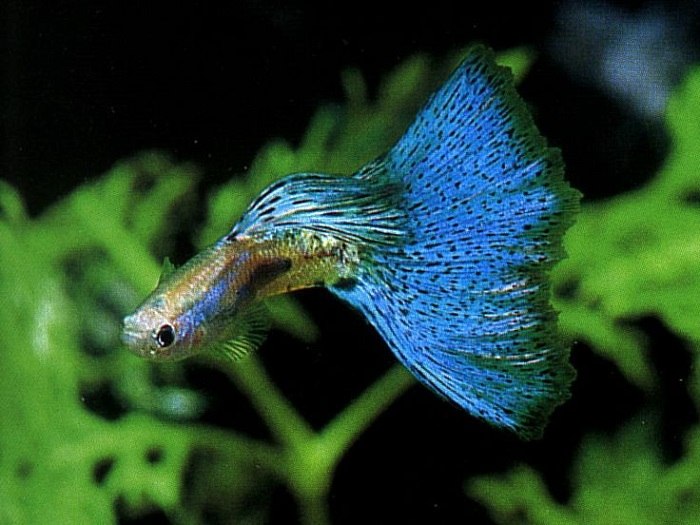
Guppies are an aquarium favorite because of their peaceful, social, and easy-going nature. They will shoal, even with other smaller species of Shoaling fish. Though it is recommended that you keep two female guppies with every male, to prevent overbreeding you can keep females together, and under the right conditions, males. Guppies are social and do need companions of the same species.
General Care
In my experience, guppies are one of the easiest and most adaptable fish species to keep. I remember having guppies as my first Tropical fish in my starter aquarium as a child. As a beginner or even a more advanced aquarist looking for more color variations, there are still a few care guidelines that we need to follow. So let’s start with creating the perfect environment for your Guppies.
Creating An Aquarium For Your Blue Guppies
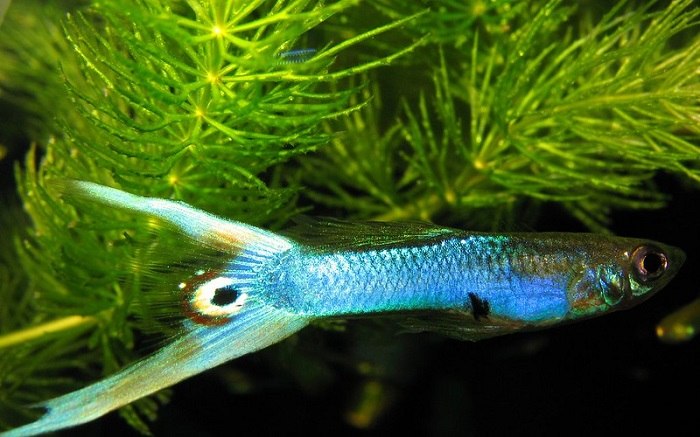
Did you know that guppies can tolerate salt water, and they can even be kept in marine aquariums? This is because they can tolerate up to 150% saline.
Still, they are much more suited to freshwater aquariums with brackish water, and a more tropical climate. Your aquarium should be decorated and designed to show off the vibrant colors and allow for the energetic nature of your guppies, simulating their natural habitat of smaller streams and pools of water.
- Tank Size – The universal rule is 5 gallons for a single guppy, with 1 gallon extra per additional guppy, though I would rather opt for 10 – 20 gallons for a group of three guppies.
- Water Conditions – Guppies prefer Brackish water thus you will need to add 1 tablespoon per 19 l (5 US gallons). They require a pH of 6.5-8.5, which is quite adaptable, and water temperatures of between 78–82°F (25.5–27.8°C, though they can tolerate colder water.
- Filtration – Guppies are small and not messy, thus they need a very light filter that has a gentle current, the best to use are a sponge or hang-on back filter. An air stone or pump for oxygen is also suitable. Likewise, you can rely on aquatic plants and bottom feeders to keep the tank clean and oxygenated in some circumstances.
- Light – They require 8-10 hours of light, guppies sleep at night. Opt for an LED light that will not cause overheating, and avoid direct sunlight which may lead to the growth of Algae and overheating.
- Heat – Guppies should never be kept in temperatures below 68 ̊ F(20 ̊ C). 50 watts per 10 gallons, and they thrive in more tropical climates of around 78–82°F (25.5–27.8°C. You can use a 50 Watt per 10-gallon tank heater.
Decorating Your Tank
Decorating your tank is one of the most exciting parts of our Guppy care journey. With their exquisite colors and vivacious personalities, you want your aquarium to truly show them off, especially your Blue Guppies.
- Substrate – We start with the substrate, choose either sand, crushed coral, or Aquasoil, and opt for darker colors to show off the Blue tones of your Guppies.
- Ornaments and Toys – With Guppies you can go all out with toys and décor, and create a theme of your own. Remember to add a few hiding spots for your guppies and other species’ companions. Anything from Castes, Shipwrecks, Rocks, Driftwood, Ceramic Pots, and even PVC Pipes is suitable. Guppies are playful and will enjoy their tank ornaments. Similarly, you can add soft silk synthetic plants or Live plants;
Live Plants
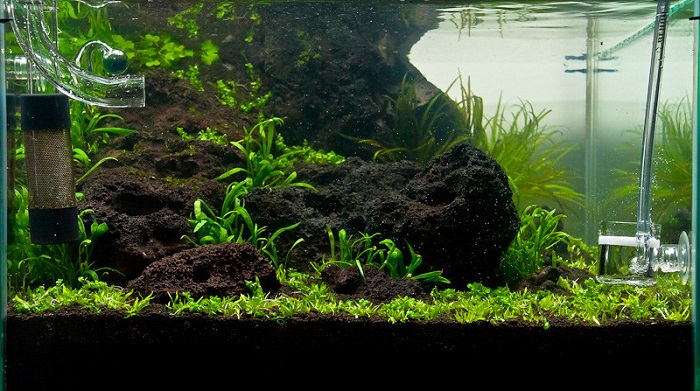
Do guppies Need Live plants?
Honestly, no guppies can thrive without Live plants, and they can easily enjoy the stimulation and hiding spaces synthetic plants and ornaments offer. Though, Live plants can help to keep your tank clean, provide oxygen, and in turn a tasty snack for fish. In well-planted tanks, with the right scavenger tank mates, you could even get away without needing a filtration system.
I always recommend live plants as they mimic the natural habitat for guppies, and for the mentioned benefits, so if you want to invest in live plants here are a few options to consider for your Guppy tank:
- Mosses – Moss is a good choice as it is dense to hide fry, provides algae, and is slowly growing. You can choose from Java Moss, Flame Moss, or Christmas Moss.
- Floating Plants – Floating plants are ideal to offer shaded coverage and cover for young fry. Though many floating species tend to grow quite fast, so you will need to remove some of them. Water Sprites, Water Wisteria, Guppy Grass, and Water Lettuce are all ideal choices, and some will even provide oxygen for your tank.
- Rooted Plants – Rooted Plants are planted in the substrate of your tank, and include Anacharis, java ferns, Anubias, Amazon sword, Hornwort, Cryptocoryne, and Moneywort that will grow continuously outside your tank.
Tank Equipment
- To keep your tank clean and in good condition, I always recommend some basic tank equipment;
- A good gravel vacuum to clean your tank.
- Liquid plant fertilizer for plants that may require additional fertilizer.
- Not a necessity but aquascape tools make planting and reorganizing your tank much easier.
- Vital is a testing kit including a digital thermometer to ensure the correct water parameters.
Placing New Guppies In The Tank

Now that you have created the perfect aquarium, and decorated it to your heart’s content, ensure that you cycle your tank for a few days, to get the water conditions just perfect, and now you can Pick out your Blue Guppies.
Choosing Blue Guppies
I highly advise that you keep one male guppy with two females, they are social and do need company, and they are quite passionate, and easy breeders which means you may have many more, should the parents not eat them first.
Should you wish to keep a single sex only a small group of three or more females will suffice, though males kept together are risky, and you will need plenty of space and hiding spaces for them.
Select a breeder or pet store of your choice that keeps healthy Guppies from trusted sources.
Other than that, we need to select a healthy young juvenile guppy. Observe the Guppy in the aquarium first; it needs to be active and lively, with no signs of damage or patches on the body. The Guppy should not look bloated, and the scales must be completely flat. Eyes need to be bright and fins upright moving around often.
How To Place A Fish In A Tank
Before placing your new guppies inside their home, they need to float inside their bag on the surface for at least 20 minutes.
Make sure the Aquarium lights are off and keep the area stress free. You will need to replace a cup of water at a time from the bag with the Aquarium water for around another 20 minutes.
Now you are ready to introduce your new guppies. You may turn the lights on after a few hours, as they will have adjusted.
Suitable Tank Mates For Guppies
Many individuals choose guppies as companions for other fish species and add them to communal tanks. Guppies are very social, active, and peaceful, yet they may fall prey to more aggressive and larger fish species, or fin-nipping fish, and they in turn will prey on small enough fish species, even their own young. Thus, choose your tank mates carefully.
Then again, though guppies are more adaptable to water parameters, they still prefer slightly brackish water, and you will need to consider this when introducing other species of fish for their well-being.
Luckily there are quite a few species that thrive with Guppies:
- Catfish Species – Smaller algae-eating catfish species such as the Octocinclus Catfish and Pygmy Cory Catfish.
- Kuhli Loaches – Nocturnal Bottom dwellers that help to clean your tank.
- Endler’s Livebearers – Closely related to Guppies, but much smaller.
- Platy Fish – Colorful Live bearing fish.
- Tetras – Tetras are small, fast, peaceful, and extremely intelligent. The best varieties to keep with guppies are; Black Neon Tetras, Ember Tetras, and Chili Rasbora.
- Rasboras – They are peaceful, communal, and schooling fish that come in a few fascinating colors; Galaxy Rasbora (Celestial Pearl Danio) and Harlequin Rasbora.
- White Cloud Minnows – Schooling fish that adapt well to colder water conditions.
- Peacock Gudgeon – Ideal if you want to keep your guppy fry numbers down, as they are peaceful carnivores that snack on smaller fish.
- Bristlenose Pleco – A small bottom feeder that eats the algae from your tank.
- Molly Fish – They are larger, peaceful fish that come in many colors, but you will need at least a 30-gallon tank for them.
- Invertebrates – Certain smaller Invertebrates are ideal as tank mates for your guppies. They comprise of; Cherry shrimp, Amano shrimp, and Nerite Snails.
Feeding Your Blue Guppies
Guppies, in general, are slow eaters, they are omnivores and enjoy a varied diet.
What To Feed
You can feed your Guppies the following;
- Meat-Based Foods – Meat-based foods such as; Brine Shrimp, Daphnia, Cooked Minced Beef, Cooked Egg Yolk, Detritus, Insect larvae, Mosquitos, and Bloodworms.
- Plant-Based Foods – Blanched Greens and vegetables; Cucumber, Shelled Peas, Lettuce, Sliced Zucchini, Broccoli, Cauliflower, and Kale.
- Flakes And Pellets – Quality flakes, pellets, granules, and algae wafers can be fed as a balanced meal.
How To Feed
Feed your Guppies a pinch of food twice a day, in the morning and evening, and give them some time between 30-60 minutes to finish eating. Scavenger fish at the bottom will easily finish the leftovers.
Feeding: twice morning, and evening, must finish within 30 – 60 minutes. Good to have scavenger fish at the bottom.
Tank Maintenance
Besides your trusted filter, algae-eating bottom feeders, and plants, you will still need to do weekly water changes of at least 25 % of the tank water, and maybe more regular if you do not have a filter.
Water changes are done by removing 25 to 30% of the tank water with a suction hose from the bottom of the tank, and replacing it with the same amount of prepared water with the right parameters and temperatures. You can follow Wikihow for detailed instructions on Tank Cleaning and Maintenance.
Common Pests And Diseases In Guppies
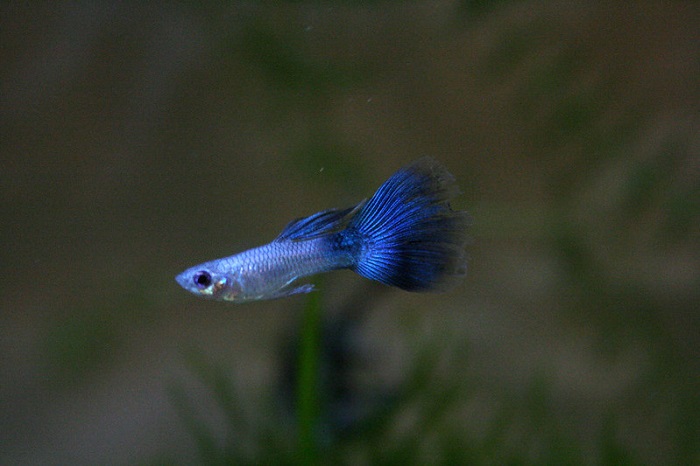
Guppies are hardy fish that can tolerate most water parameters and rarely get sick, though there are a few pests and illnesses that can trouble them;
- White Spot Disease/Ich
- Symptoms: A parasite causing White residue on the body and loss of appetite.
- Cause: Stress and Poor Water Conditions.
- Treatment: Clean tank for quarantine, with higher temperatures, medication such as Malachite Green and Formalin, and aquarium salts.
- Fin And Tail Rot
- Symptoms: Torn or ragged fins, white edges, or red stripes on the fins and tail.
- Causes: Bacterial infection Caused by Fungus due to Dirty Water, or Ammonia Burns mostly.
- Treatment: Quarantine in a clean tank and use, Antibiotics, and Fungal Medication.
- Swim Bladder Disorder / Dropsy
- Symptoms: Issues staying upright, Lethargy, Clamped fins, and loss of appetite. Difficulty maintaining balance.
- Causes: Infection or damage to the Swim bladder from many causes such as poor diet, stress, physical injury, or poor water conditions.
- Treatment: Though rare in guppies, it can be treated with Quarantine in very clean water, with high temperatures, and regular water changes.
- Columnaris & Mouth Fungus
- Symptoms: Cloudy splotches on the mouth or body of the guppy.
- Causes: A highly infectious bacterial fungus that can be deadly.
- Treatment: Quarantine all affected fish and use a strong chemical medication from your vet, or plenty of aquarium salt and minerals, added to the tank.
- Gill Flukes
- Symptoms: A common guppy disease where small white worms appear on the gills, and cause difficulty breathing.
- Causes: Contracted from infected new fish or plants, or caused by poor water conditions.
- Treatment: Treated with specific medication from your vet.
Disease Prevention
Prevention is always easier than cure, and as you will see in most cases Guppie disease is caused by poor water conditions or a poor diet.
Always ensure your water parameters are at optimum levels, and try to quarantine new fish or plants in a separate tank for a while before adding them to their tank.
How To Breed Blue Guppies

Guppies are quite enthusiastic when it comes to breeding, and they will easily breed inside the tank. They are livebearers giving birth to small fry, but unfortunately, they are also cannibals that enjoy eating their young. So if you want the young to survive in your initial tank you can add plenty of hiding spaces and plants for the small fry and hope for the best, or you could rather opt for a separate breeding tank.
Always allow two to three females per male, as they chase females around relentlessly, and make sure to remove the adults immediately after all fry have been born.
You can also breed for specific colors and tail variations by investing in guppies of similar colors and desired variations to breed with.
Though, may individually prefer not to breed their guppies as it can lead to inbreeding that can cause deformities in the young, in which case you have a few options;
- Keep only female guppies.
- Keep smaller, peaceful carnivorous fish, or other fish that will eat the fry.
- Allow your guppies to feed on their fry.
Breeding guppies is essentially easy, though there are so many factors to the entire process, so if you want to learn more from “Your Aquarium Place”, which will soon be featuring a dedicated article for guppy birth and breeding.
Final Thoughts

Lastly, I hope you found the information on the Blue Guppy informing and entertaining. Guppies have general easy-care requirements and are hardy, adaptable fish. The Blue guppy is an exquisite color to start with or to add to the rest of your collection.


